The most vulnerable and impoverished populations live in 46 nations designated by the United Nations (UN) as the world’s least-developed countries (LDCs). Lacking adequate food security, drinking water and electricity, they are more vulnerable to economic and environmental catastrophes. Notably, the COVID-19 pandemic dramatically affected economic growth in these countries.
Nature Index 2023 North–south collaboration
LDCs have a gross national income of US$1,088 per capita or below, according to the UN’s definition, leaving most with limited capacity to invest in making scientific advances. The average LDC government invests just 0.21% of gross domestic product in research and development, compared with an average of 0.93% across all countries. The mean number of PhD students per million people in an LDC is 45, as opposed to almost 800 globally. And LDCs produce only 23 scientific publications per million people, compared with an average of 562 across all countries.
Researchers in the poorest nations are therefore often dependent on foreign investors for access to scientific equipment, advanced-degree opportunities and training.
Nature Index spoke to researchers based in four LDCs — Senegal, Haiti, Nepal and Cambodia — about what works and what doesn’t when global-north countries attempt to collaborate and bolster research capacity in their nations.
BALLA DIOP NGOM: Partner with institutions abroad to train students
Nanomaterials physicist at Cheikh Anta Diop University, Dakar, Senegal.
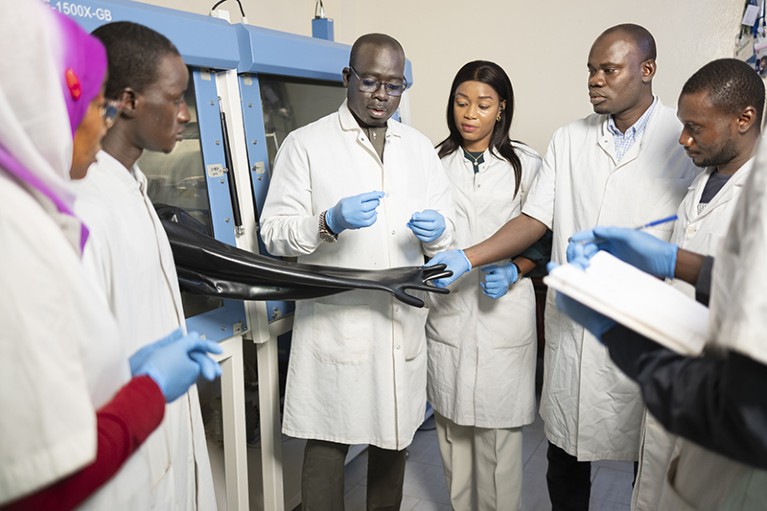
Balla Diop Ngom with students at his Quantum Photonics, Energy and Nanofabrication laboratory at Cheikh Anta Diop University, Senegal.Credit: Sylvain Cherkaoui/Panos Pictures for Nature
My laboratory was the first to train PhD students in material-sciences research in Senegal. I have 11 PhD students and 10 master’s students, and I have graduated 7 PhDs. It’s possible to study up to a PhD level in Senegal, but because we lack state-of-the-art equipment, some people opt to focus on theoretical dissertation projects.
We often rely on science diplomacy with other countries to produce our own lab-based science. To get access to equipment and training, I designed a concept to create a memorandum of understanding (MOU) between our university and those abroad. For example, in data science, I have a MOU with the National Institute of Scientific Research in Montreal, Canada, to access facilities such as high-resolution electron-microscopy equipment and X-ray diffraction technology. Our joint proposal received funding from Canada’s International Development Research Centre. We ask our students to go there for three to six months to conduct research using their equipment. So far, four of my students have gone to Montreal; the first graduated in November. It is sometimes difficult to set up MOUs between two universities, however, especially when one is English-speaking and the other is French-speaking. Two MOU documents are drawn up in each language.
Another strategy is to help the student secure funding, as well as a place in a collaborator’s lab. In this scenario, there is no MOU between our institutions, but the student is fully funded. For example, working with a collaborator at Drexel University in Philadelphia, Pennsylvania, I developed a research project to work on 2D materials needed for storage devices or renewable energy, and then I selected students in Senegal to apply for Faculty for the Future fellowships from the Schlumberger Foundation in Houston, Texas. I’ve had one postdoc and a PhD student get these fellowships to do the work at Drexel. These collaborative training strategies are not common practices in Senegal and it’s not really a strategy that researchers can use unless they have already built an international network.
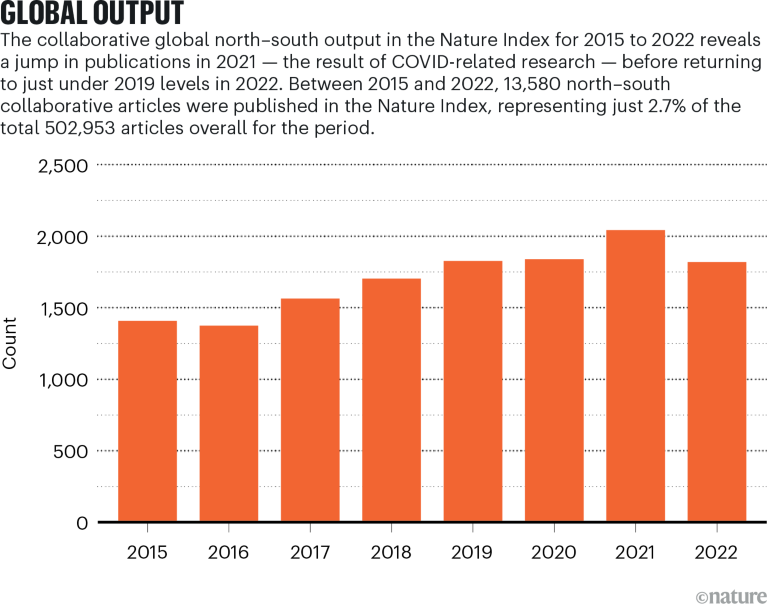
Source: Nature Index/Dimensions by Digital Science
My first important grant came from The World Academy of Science (TWAS), which gave me around US$16,000 for one year, allowing me to build my lab and buy equipment. Next, I secured a two-year Future Leaders — African Independent Research Fellowship of roughly £300,000 (US$364,239) from the Royal Society, UK, and the African Academy of Sciences. This helped me train students and send them, and myself, around the world to attend conferences and network. I have another TWAS grant for US$35,000 to buy equipment and chemicals, and attend conferences. Global organizations need to know that although it is important to fund students in Africa and other developing regions, it is also crucial to channel funding to supervisors so they can maintain a steady stream of PhD students.
Interest from students in science has been growing in the past five to ten years, but there is very little government money available for training. The few grants that the Senegalese government provides make it difficult to do science because researchers receive only half of the money upfront; the rest is delivered once the project is done. I have never applied for a grant from the government of Senegal. At the same time, the small grants that we receive from global-north countries are not enough to buy big equipment. For example, a scanning electron microscope can cost US$1 million.
One thing that would help students in African nations is to have high-level scientific meetings convened there. Scientists in developing countries don’t have grants to travel. Organizing this type of meeting in these areas will help scientists network and develop collaborations.
SAVOUERN SOUM: Collaborate regionally to prepare future leaders
PhD student in applied ecology and management at the Royal University of Phnom Penh, Cambodia.
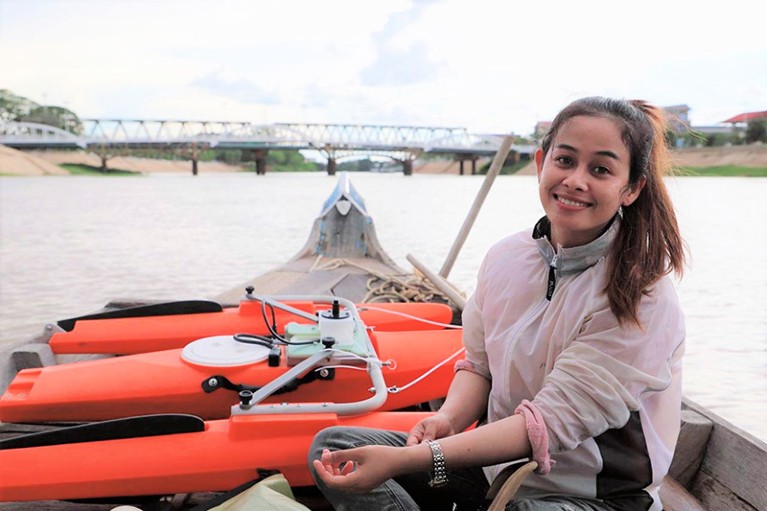
Savouern Soum studies the Tonlé Sap, a vast freshwater lake in Cambodia, and its tributaries.Credit: Chhut Chheana/Wonders of the Mekong
I started my PhD in 2020 to focus on water quality in the Tonlé Sap, the largest and most productive lake in southeast Asia. Tonlé Sap is very important here in Cambodia, as well as Thailand and Vietnam, because so much food production occurs in and around it. My research suggests that fish may be declining owing to decreased water quality — notably low oxygen — around the lake, which is linked to the increased use of chemical fertilizers for rice production in the area. At the same time, additional water use upstream robs the lake of water, so the nutrients become concentrated and oxygen levels drop, harming fish.
In 2020, I got an opportunity to study water chemistry from the Wonders of the Mekong, a programme developed by the University of Nevada Global Water Center in Reno, and government agencies in the United States and Cambodia, to boost research into the Lower Mekong river basin. I learnt about the many different ways that people live around Tonlé Sap and how it’s interconnected with their lives. It’s really hard to do a PhD in Cambodia because there are limited government funds; graduate-student funding in Cambodia is primarily from other countries.
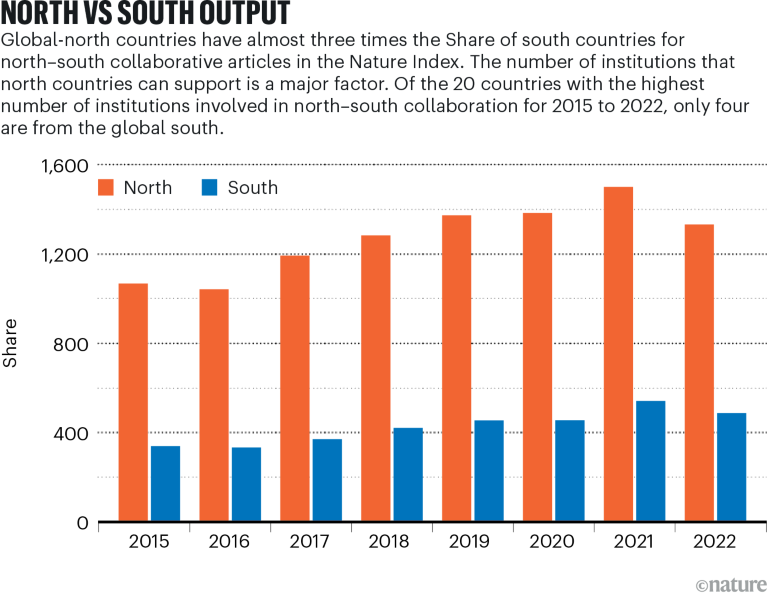
Source: Nature Index/Dimensions by Digital Science
I’ve also applied for funding from NexGen Mekong Scientists, a programme supported by the US Department of State, to bring together early-career scientists in the four countries — Cambodia, Thailand, Vietnam and Laos — that depend on the Mekong River. The funding paid for my travel to Tulane University in New Orleans, Louisiana, to learn more about the work of other scientists on these same issues. There, I got experience with new field techniques and learnt how to adapt different designs to fit my study area.
Our government needs scientific research results. Other countries are free to do what they want with the Mekong River because we don’t have evidence of the downstream impacts. For example, dams built farther upstream, very far away from Cambodia, reduce the amount of water that the lake receives. This increases the concentration of nutrients, because the Tonlé Sap Lake depends on the Mekong for 50% of its inputs.
I hope the NexGen programme will help me gain experience in how to sustain research projects over the long term. Often, we get funding for equipment, but then there are so few people who are trained to use the equipment that it can sit idle after people graduate or the project ends. We need funding to maintain a flow of students, and their knowledge of equipment and laboratory techniques, to sustain research efforts. The best part of NexGen is that they are supporting researchers in all four countries along the Mekong, which helps us to create collaborations on cross-border projects to improve environmental conditions for everyone.
ANUSHIYA SHRESTHA: Enable local scientists to generate data
Research director of the South Asia Institute of Advanced Studies in Kathmandu, Nepal.

Anushiya ShresthaCredit: Pradip Dhakal, Communication &IT Associate, SIAS
I work at the South Asia Institute of Advanced Studies, which provides research-based policy recommendations on social environmental issues to local, provincial and federal governments, notably natural-resource and disaster-risk-management agencies, in Nepal. We only have around 20 staff; it’s not a big organization. We also have part-time colleagues who are faculty members at universities abroad, in locations such as Sweden, Australia and the United States.
International funders are our biggest source of grants. We have received grants from the International Development Research Centre based in Ottawa, Canada; the Swedish Research Council; the UK’s Economic and Social Research Council; the Climate and Development Knowledge Network headquartered in Cape Town, South Africa; and the Dutch Research Council. Currently, we have programme funding worth 20.5 million Nepalese rupees (US$154,000). Although many international organizations are active as development partners, the number of research partners is quite limited by comparison.
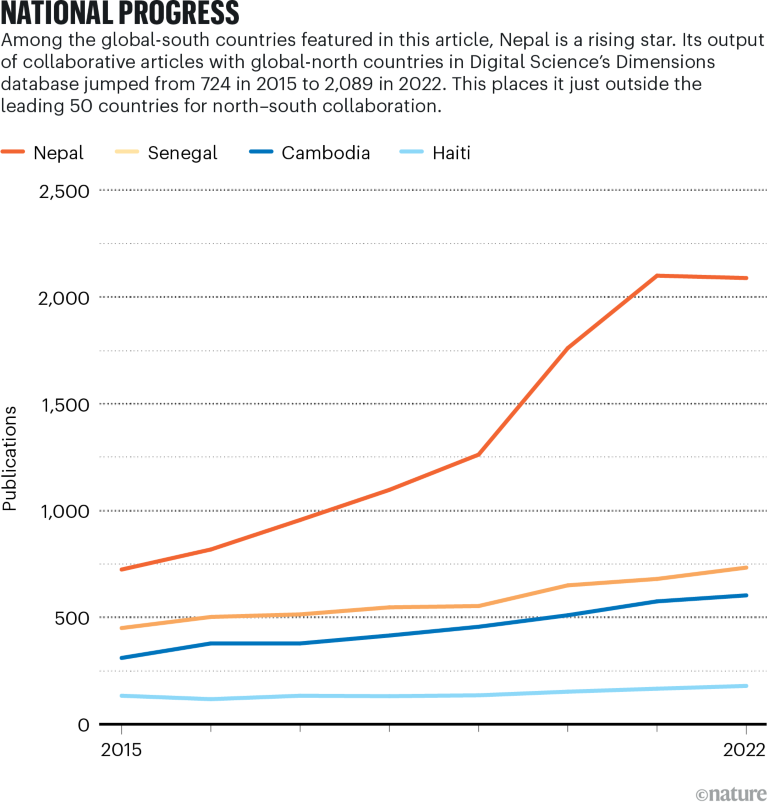
Source: Nature Index/Dimensions by Digital Science
In Nepal, it can be tough to collaborate with international partners, given how strict our government is about sending money out of the country. Even if we lead a project, and the grant funding comes to our account, it can be difficult to transfer it to fund collaborators abroad. There is very limited funding from the government annually for research. As a result, there are very limited opportunities — particularly for students and researchers who are trying to do social science. Academic opportunities, such as PhD training, would not have been possible for many of us without international scholarships.
A consistent challenge we face is that grant calls are driven by a global agenda, which does not always match local contexts in the developing world. For example, forest conservation is essential, but there are real-life challenges connected with increasing forest coverage, such as human–wildlife conflicts and food–water insecurity. These needs can be deemed ‘too local’ or of limited scope to funders or northern colleagues. Language limitations are also a common problem across the global south. As a result, sometimes the northern researcher will do the final writing of proposals and editing of publications. One challenge is that we, as a policy institute, want to emphasize the empirical findings, but the northern partner can have different priorities, such as pushing new analytical frameworks and decision-making tools. We have also experienced cases in which contributions of the global south are considered secondary compared with the theoretical arguments led by the northern partners.
AXLER JEAN PAUL: Provide funding for chronic health concerns
Axler Jean Paul graduated in medicine at the State University of Haiti and is currently volunteering at the University of Louisville.
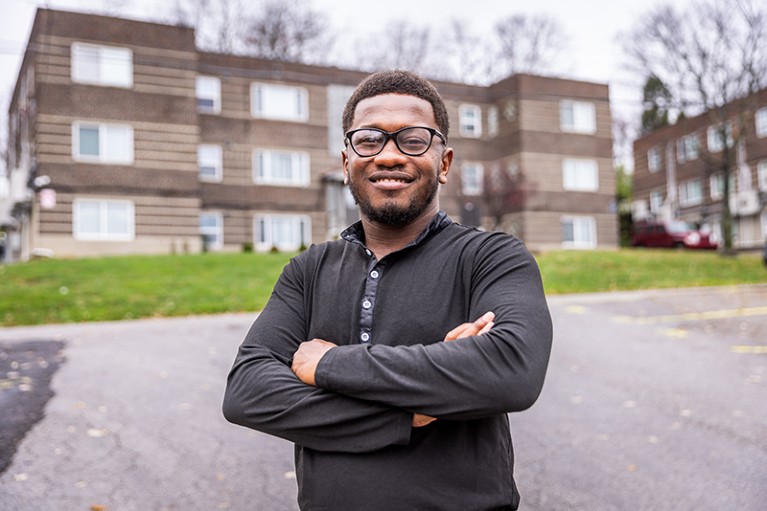
Axler Jean Paul hopes to return to Haiti after completing a US hospital residency.Credit: Matthew Allen for Nature
I graduated last year from the State University of Haiti, in Port-au-Prince, the only free public medical school in the country. The seven-year programme devotes five years to medical school, one year of internship at the State University of Haiti Hospital and another year working in the community. There’s far more student interest than there is capacity to train. When I applied, there were 8,000 applicants for only 125 spots. There are also five private schools of medicine in Haiti, but they cost roughly 200,000 Haitian gourdes (US$1,508) per year. It is more than most Haitians can afford in a country with a net per capita annual income of around US$1,725. At most, maybe 5–10% of the students get training outside the country, because there is no financial aid.
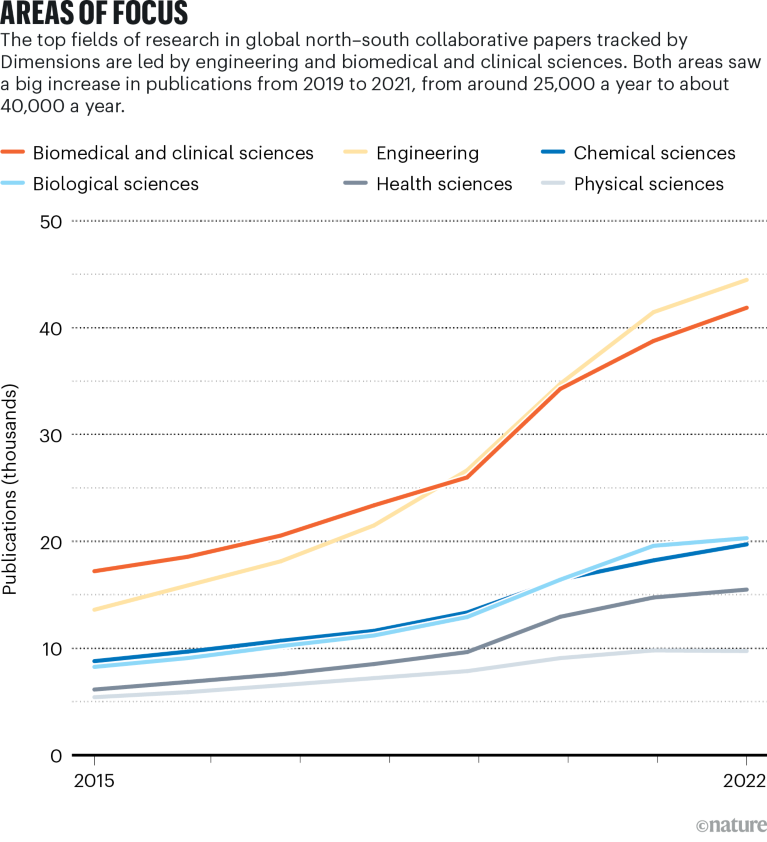
Source: Nature Index/Dimensions by Digital Science
A big challenge for clinical researchers in Haiti is the lack of quality medical data. We also have only one national journal where scientists can publish. There is not enough expertise among the professors to train students, especially in medical specialities. For example, we don’t have any cardiac surgeons. One of the biggest challenges is that most of the funding that comes to Haiti for medical research is for infections such as cholera and HIV. But there are so many other problematic conditions that need to be addressed, including diabetes and hypertension and neurological disorders. I want global-north colleagues to realize that there’s more to public health in Haiti than just a couple of infectious diseases. We need medical training in, for example, neuroscience. We only have eight computerized tomography scanners for the whole country, and it costs US$200–300 for a patient to get a scan.
To get experience in neurology, I paid — with my family’s help — for my own trip to the United States in May this year. I reached out to a colleague at the University of Miami in Coral Gables, Florida, who helped me to connect with faculty members working on stroke research. I passed the first of three exams to receive a US medical licence in August and in October, I travelled to Kentucky to volunteer at the University of Louisville’s neurology department, which has a research programme on spinal cord injury. Once I finish the exams, I will probably go to Miami to get more experience in another hospital to strengthen my application for residency at one of the top training hospitals in the United States. After I finish a residency, in about five years, I want to take my expertise back to Haiti.

 North–south publishing data show stark inequities in global research
North–south publishing data show stark inequities in global research
 North–south country collaborations reveal untapped potential
North–south country collaborations reveal untapped potential
 Is the EU–Africa innovation plan toothless?
Is the EU–Africa innovation plan toothless?
 How to level the global publishing playing field
How to level the global publishing playing field






